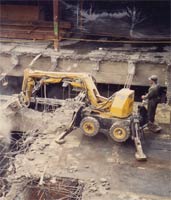
Best practices keep demolition's dangers to a minimum.
Ensuring Job Site Awareness
- By Michael R. Taylor, CAE
- Jul 01, 2008
 Although the prevailing perception is that the
demolition industry by its very nature is a
dangerous business, the truth is that the industry’s
continued commitment to safety
education and best practices is creating a relatively safe
industry in which to work. There are no government
statistics that isolate the number of fatalities that occur
specifically in the demolition industry, but the National
Demolition Association (NDA) points to the fact that
the number of fatalities in the construction industry
overall has remained relatively constant for 20 years
while the total volume of construction jobs undertaken
in our economy has quadrupled. The obvious conclusion
is that great strides have been made in the area of
occupational health and safety.
Although the prevailing perception is that the
demolition industry by its very nature is a
dangerous business, the truth is that the industry’s
continued commitment to safety
education and best practices is creating a relatively safe
industry in which to work. There are no government
statistics that isolate the number of fatalities that occur
specifically in the demolition industry, but the National
Demolition Association (NDA) points to the fact that
the number of fatalities in the construction industry
overall has remained relatively constant for 20 years
while the total volume of construction jobs undertaken
in our economy has quadrupled. The obvious conclusion
is that great strides have been made in the area of
occupational health and safety.
A number of initiatives created by NDA highlight
the industry’s continued commitment to safety on the
job site. The “Demolition Safety Manual,” viewed by
many as the first and last word in demolition safety
practices, catalogs the safest ways to perform diverse
tasks when demolishing structures. If properly used, the
manual will help lead to fewer injuries, safer work sites,
and lower worker’s compensation premiums. The reference
book translates OSHA regulations into actions
for the industry professionals and is meant to be used
in connection with each company’s training program in
safe work practices. It is an important tool in NDA’s aggressive
safety program, which also includes the Hazard
Communications Program Manual and the association’s
safety DVD series.
Some of the topics covered include:
• Motivating employees
• Equipment safety, including preparation and use
of material handling equipment, trucks, and other
heavy equipment
• Preparing engineering surveys, utility location,
medical services, and fire prevention
• Protective structures, such as signs and lighting
• The safe use of ladders, cranes, and manlifts and
the implementation of shoring
• Personal Protective Equipment
• Fall prevention
• Debris removal
• Handling hazardous materials, including asbestos,
PCBs, and lead
• Safe use of hand tools, such as pneumatic power
tools, abrasive blade tools, and chainsaws
Annual Demolition Safety/Management Summits
have been held for 13 years to address topics that affect
those in the demolition process. This year’s summit,
to be held in October in Atlanta, has been expanded
and named the “Demolition Academy.” It will
offer specialty certification courses in areas including
confined space rescue, aerial lift equipment safety, and
fall protection specifically for the demolition industry.
Included in the program will be a demolition project
site management training course and also a demolition-
specific OSHA 10-hour safety training course,
which is a prerequisite for a Disaster Site Worker Certification
that is likely to be required by OSHA for industry
personnel working on any disaster site.
Another initiative is a series of bimonthly “Demolition
Safety Talks.” These toolbox safety talks can be used
on industry work sites to alert workers to particular hazards
they may face. The talks also assist workers with occupational
safety and health compliance. These prepackaged
toolbox safety meetings are aimed at
medium-sized and smaller demolition contractors who
may not have the resources to employ a full-time safety
director. In these cases, the job usually falls on the shoulders
of the project manager, who is a person pulled in
many directions during a demolition project. Topics covered
in this series include fall protection, scaffold safety,
electrical safety, and the operation of heavy machinery.
First Step is Preparation
There are general practices employed by most demolition
contractors on a demolition project. The first is
preparation.
To avoid potential dangers, the contractor must embark
on advance planning. Most contractors perform
an engineering survey before employees even touch a
building. A team made up of the estimator, safety director,
field superintendent, and foreman go through
the survey and discuss everything that could possibly
happen. Every problem area is examined, and the correct
procedure to handle it is devised.
Demolition contractors should inspect the site to be
demolished closely to be sure there is no live electric circuit,
gas or flammable liquid in a pipe, or some hazardous
substance left in a vessel. Experienced contractors
know there is often no second chance to get it right.
Safety meetings are essential so every worker knows
every potential hazard and how to avoid injuries and fatalities.
During the project, safety meetings continue,
even on a daily basis, to ensure all safety hazards are
communicated and immediately corrected.
Information should be distributed to all job sites as
a way to share knowledge and experiences. One major
contractor developed a series of cards for employees to
carry in their pockets and use to jot down potential safety
hazards they might notice in the course of a job.
Workers are required to fill these cards out every day so
management can be sure they are always on the lookout
for hazards.
Workers are told to report every injury to prevent a
cut or burn from becoming infected. Because the contractor
has the liability for every worker’s well-being, instant
communication of injuries is a top priority. Even
non-incidents—accidents that could have happened
but did not—should be reported.
Using the Right PPE
Personal Protection Equipment plays a leading role in
protecting the safety of demolition workers. Working
around rubble requires heavy leather boots with thick
soles to avoid cuts and punctures. One step better are
boots with puncture-resistant soles and steel toes when
working around nails and other sharp objects.
To protect the hands, workers can use cloth gloves
for most rough work or leather gloves when working
around metal or sharp edges. When solvents or chemicals
are present, safety directors direct the use of rubber
gloves. Moving upward, every worker, without exception,
must wear a hard hat on the site. Contractors provide
safety glasses, goggles, and faceshields according to
the type of hazard the worker faces. Workers are strongly
encouraged to report eyewear that is scratched or
hard to see through.
The rule of thumb for hearing protection is that if a
person must raise his voice to be heard by another only
a few feet away, ear plugs or ear muffs are necessary.
Safety directors employed by demolition contractors
are knowledgeable about the correct respirator to
choose based on the hazard present. For example, a dust
mask is not rated for asbestos, and a respirator a person
would use for asbestos or lead may not work to protect
against vapors. In a low-oxygen environment, such as
dismantlement inside a confined space such as an industrial
tank or vessel, a filter respirator will not supply
any additional air. Such conditions demonstrate why
the safety director’s supervision and up-to-date knowledge
are so essential.
Safety precautions may not always involve the use
of PPE but may instead require simply staying in
shape and observing rules for lifting and moving
heavy objects. Workers should, as a matter of course,
incorporate stretching exercises into their preparation
for the work day.
Collapse Dangers
One risk present in nearly every demolition is the possibility
the structure may collapse unexpectedly. One
thing to look out for is to be sure there is no tension
built up on a structure’s member that is being cut that
may lead to a release. Another potentially dangerous situation
is working around large vehicles and equipment
where every vantage point may not be visible. It becomes
the responsibility of nearby workers to stay clear,
which includes not standing under a crane or next to a
truck that is being loaded in case materials slip and fall.
Easily understood, agreed-upon hand signals by a
person on the ground and someone operating large
equipment—communicating everything from danger
to where to place a load—can be the difference between
safety and injury on a demolition site.
Planning an escape strategy is another way to keep
the work site safe. For example, when working on the
upper floors of a building being demolished, it is necessary
to know several escape routes to take if a dangerous
situation should arise. Avoiding “pinch points” is
important so that no one gets caught in position near
equipment or in a building where there is no exit.
Making common-sense use of barriers also avoids
problems on site. Barriers prevent workers from wandering
into a work area, getting too close to an edge,
or standing under an overhead load. They keep unauthorized
people out and are needed to restrict pedestrian
traffic.
Conscientious and consistent use of a safety harness
is the best way to avoid falls for any height more than 6
feet off the ground without a handrail. When tying off,
a structural element must be used that can take the sudden
impact of the fall and person’s weight. The best
choice is to tie off the lanyard to a strong structure,
preferably overhead, so that there is no way the fall will
be more than 6 feet.
Throughout a demolition project, workers must
keep their work area clean and keep a pathway cleared
for the equipment and trucks that need access to the
site. As trucks prepare to leave the site and haul demolition
debris away, it is necessary for the truck to carry
a balanced load that should not be overweight or have
any material sticking out. Drivers should always keep in
mind the road conditions ahead that may cause a load
to shift or present a low-clearance problem.
It is strict adherence to best practices such as these and
the demolition industry’s dedication to the awareness and
enforcement of workplace safety that has kept it a surprisingly
safe business in the global marketplace.
About the Author
Michael R. Taylor, CAE, is executive director of the National Demolition Association, a nonprofit trade organization representing more than 1,100 U.S. and Canadian member companies involved in the demolition process. You can visit the company Web site at www.demolitionassociation.com